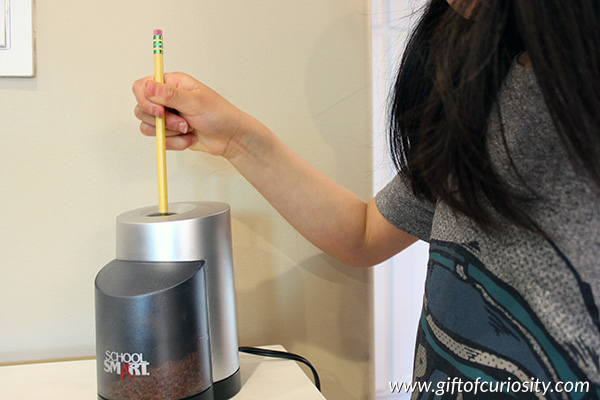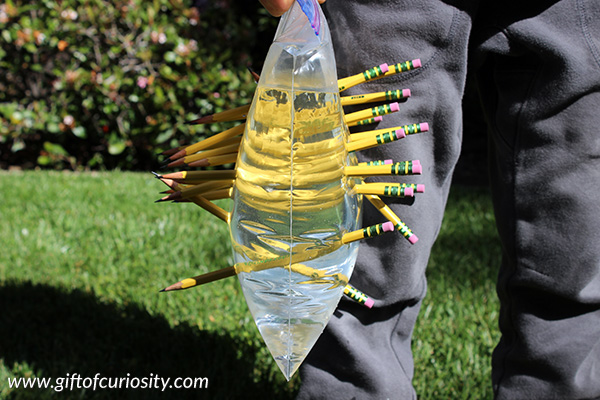This post may contain affiliate ads at no cost to you. See my disclosures for more information.
So one day recently I filled a plastic bag with water. Then I handed my kids some sharpened pencils and asked them to poke holes in the bag.
They looked at me like I was crazy.
I can’t say I blame them. Even I wasn’t entirely sure my plan was going to work. There was always the possibility that we would have all ended up soaking wet.
But fortunately, science won out and we stayed dry, even after punching a number of holes in the bag.
And that was how I started our lesson about polymers. 🙂
Note: Find more science experiments on my Science Activities for Kids page!

The Leak Proof Bag
The leak proof bag is a high interest activity to introduce your children to polymers, specifically a polymer called low-density polyethylene (LDPE).
And if you don’t care to get into the nitty gritty of the science, it just makes for a really fun experience.
To do this activity, you will need to gather the following materials:
- a plastic bag (we started with a gallon size Ziplock brand bags)
- pencils with rounded sides (rather than flat sides)
- pencil sharpener
- water
Begin by ensuring all of your pencils are very sharp.

Then fill your plastic bag at least half full with water.

Ask your child to poke a hole in the bag with a pencil. Tell them to poke the pencil through both sides of the bag, but not to poke the pencil all the way through.
(If you are worried about spillage, consider doing this part of the activity outdoors or over a sink.)

If your children feel so inclined, have them continue to stick pencils into the bag.

We ended up with more than a dozen pencils in our bag.

And despite all the holes, there were no leaks!

We talked about polymers and how they create a seal around the pencils, effectively closing off any holes in the bag.
We decided to see if other types of plastic bags would do the same thing. So we grabbed a plastic bag I picked up from the bulk food aisle of our grocery store.
This bag was made of a thinner material than the first bag we used, but it was still relatively sturdy.

We stuck some pencils in, feeling some trepidation as to whether the bag would leak or not.

But this bag was also leak proof.

So we decided to try with another plastic bag. This time we used a thin, cheap plastic bag from the produce section of the grocery store.

We stuck some pencils in and the bag quickly began to leak.

The holes did not seal up around the pencils but gaped and allowed water to escape.
We were glad we did this part of the experiment outdoors!
The Science Behind the Activity
What is a polymer?
A polymer is a chemical compound that has molecules bonded together in repeating chains. The term polymer is often used to describe plastics.
Polymers have unique properties that can be tailored for different uses.
For example, useful properties of polymers include being lightweight but strong, being non-conductive in terms of heat or electricity, resistance to corrosion, transparency, and low cost.
Low-density polyethylene
One common type of polymer is polyethylene, which is made of chains of ethylene (C2H4) molecules. Polyethylene comes in various forms, one of which is low-density polyethylene (LDPE).
LDPE is one of the most widely produced plastics in the world. LDPE is a very flexible material with high ductility (the amount it can deform before rupturing) but low tensile strength (the amount of stretching it can endure before breaking).
LDPE’s unique properties, including its low cost, light weight, durability, flexibility, and the fact that it is waterproof make it highly valued as a packaging material. Indeed, many plastic bags, such as the zip top bag used in this activity, are made of LDPE.
How LDPE creates a leak proof bag
Polyethylene molecules are flexible but weak. Therefore, they separate easily to make a hole where the pencil is poked in, but they flexibly seal around the pencil to prevent the water from leaking out.
When the pencil is removed, the hole in the bag remains and the water leaks out.
It is easier for the polyethylene molecules to seal around the edges of a rounded pencil than a pencil with flat sides. So if your bag leaked, check that you used rounded pencils. Also, make sure the pencils go in straight so the hole they create is the same diameter as the pencil.
More science activities for kids
More science posts from Gift of Curiosity:
- Dancing raisins
- DIY glitter bouncy balls
- Candy experiments
- Jumping colors science activity
- Make your own glycerin soap
- Make your own telescope
- Magic inflating balloons
Find more great science activities on my Science Activities for Kids page and my Science Activities Pinterest board.




I tried this not thinking it would work with sandwhich bag but amazingly it did
Awesome!